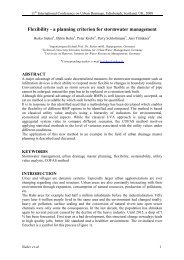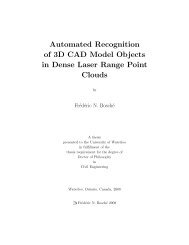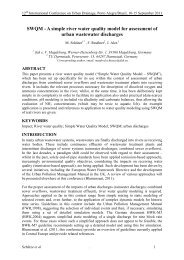ACME 2011 Proceedings of the 19 UK National Conference of the ...
ACME 2011 Proceedings of the 19 UK National Conference of the ...
ACME 2011 Proceedings of the 19 UK National Conference of the ...
You also want an ePaper? Increase the reach of your titles
YUMPU automatically turns print PDFs into web optimized ePapers that Google loves.
( , t)<br />
t<br />
v = Dx<br />
Dt = ∂x<br />
X ∂ but material points are not necessarily tracked in <strong>the</strong> case <strong>of</strong> <strong>the</strong> mapping<br />
* *<br />
*<br />
χ ֏ x χ , t . Note <strong>the</strong> use <strong>of</strong> D<br />
*<br />
D t ra<strong>the</strong>r than <strong>the</strong> ordinary derivative d dt in equations (1) even<br />
( )<br />
though <strong>the</strong>se are identical when applied to a function <strong>of</strong> t. Although <strong>the</strong> integrals ∫ Ω ρhdV and ∫ Ω ρdV<br />
* *<br />
are functions <strong>of</strong> t <strong>the</strong> derivative D D t is used to immediately relay <strong>the</strong> notion that Ω is a control<br />
*<br />
*<br />
volume transported through v . Although v is present in equations (1) it cannot influence <strong>the</strong> value <strong>of</strong><br />
ψ as this would be physically meaningless. Typical transport equations are:<br />
*<br />
D *<br />
D<br />
t<br />
*<br />
D t<br />
∫<br />
∫<br />
ρdV + ∫ ρ<br />
∫<br />
( v − v ) ⋅ ndΓ<br />
= 0<br />
*<br />
Ω Γ<br />
*<br />
D *<br />
D<br />
t<br />
∫<br />
( v − v ) ⋅ ndΓ<br />
= ∫ v ⋅ σ ⋅ ndΓ<br />
− ∫ q ⋅ ndΓ<br />
+ ∫ ρQdV<br />
+ ∫<br />
ρedV + ρe<br />
ρv<br />
⋅ bdV<br />
Ω<br />
Γ<br />
*<br />
D *<br />
∫<br />
( v − v ) ⋅ ndΓ<br />
= ∫ σ ⋅ ndΓ<br />
+ ∫<br />
ρvdV + ρv<br />
ρbdV<br />
*<br />
Ω<br />
Γ<br />
Γ<br />
Ω<br />
*<br />
D *<br />
−1<br />
−1<br />
∫ sdV + ∫ρs(<br />
v − v ) ⋅ ndΓ<br />
≥ −∫<br />
T q ⋅ ndΓ<br />
+ ∫ρT<br />
*<br />
D t Ω<br />
Γ<br />
Γ<br />
Ω<br />
ρ QdV<br />
Γ<br />
Γ<br />
1<br />
for transport <strong>of</strong> mass, energy, momentum, and entropy, where = u + v ⋅ v , u and s are internal energy,<br />
Ω<br />
e 2<br />
and entropy per unit mass, q ⋅ n is heat flux, Q represents a heat source, σ is <strong>the</strong> Cauchy stress tensor<br />
and b is a body force. The equality arising in equation (5) is as a consequence <strong>of</strong> irreversibly arising<br />
from finite temperature differences and dissipation.<br />
3 MECHANICAL ENERGY EQUATIONS AND DISSIPATION<br />
A particular interest here is <strong>the</strong> splitting (if possible) <strong>of</strong> <strong>the</strong> energy equation (3) into <strong>the</strong>rmal and<br />
mechanical parts. To achieve this partition it is shown here that a necessary and sufficient condition is<br />
that <strong>the</strong> solid possesses an entropy function that is dependent on temperature only. Consider for<br />
demonstration purposes <strong>the</strong> deformation <strong>of</strong> a hyperelastic material.<br />
Theorem 3.1 A hyperelastic material dependent on state variables temperature T and <strong>the</strong> independent<br />
strain components E ij <strong>of</strong> <strong>the</strong> Green-Lagrange strain tensor E has internal energy in <strong>the</strong> form<br />
T E<br />
u u u<br />
= + , where<br />
T<br />
u and<br />
dependent on temperature only.<br />
E<br />
u are functions <strong>of</strong> T and ij<br />
Ω<br />
(2)<br />
(3)<br />
(4)<br />
(5)<br />
E , respectively, if and only if its entropy is<br />
Pro<strong>of</strong> 3.2: The central equation <strong>of</strong> <strong>the</strong>rmodynamics for <strong>the</strong> solid is Tds = du − dwR<br />
, where reversible<br />
differential work dw<br />
−1 −1<br />
= ρ dω = ρ S: dE , and where strain energy ( ) E S : E<br />
~<br />
ω<br />
E ij<br />
= ∫ S d 1 = , E is<br />
R 0 0 0<br />
0 Eij 0<br />
ij ij 2<br />
<strong>the</strong> Green-Lagrange strain measure, which is work conjugate to <strong>the</strong> 2 nd Piola-Kirch<strong>of</strong>f stress S . Here 0 ρ<br />
represents <strong>the</strong> density in a material reference configuration and by construction ρ σ : εɺ<br />
= ρS:<br />
Eɺ<br />
, where<br />
E ɺ represents material strain rate and εɺ is <strong>the</strong> Eulerian strain-rate tensor.<br />
Consider internal energy <strong>of</strong> <strong>the</strong> form u( T,E ij ) with <strong>the</strong> central equation <strong>of</strong> <strong>the</strong>rmodynamics<br />
−1<br />
( Tds dT − ∂u ∂ T) dT = ( ∂u ∂Eij − ρ 0 Sij ) dEij<br />
under <strong>the</strong> assumption s = s( T)<br />
and it immediately<br />
follows that<br />
2<br />
∂ u ∂Eij∂ T = 0 hence<br />
T E<br />
u u u<br />
= + is obtained on integration. Similarly, conversely,<br />
assuming internal energy to be <strong>of</strong> <strong>the</strong> form<br />
0<br />
T E<br />
u u u<br />
= + gives<br />
10













